Introduction
The banded mongoose (Mungos mungo) is a highly social, small weasel-like carnivorous mammal found across Africa, with the exception of the Congo and southwestern Africa.1https://nationalzoo.si.edu/animals/banded-mongoose They get their name from the black bands that run horizontally across their coarse, grey fur from the top of their back to the base of their tail. The banded mongoose is widespread across Uganda. They can be seen in all national parks and is not under threat. Banded mongooses live between 11 and 13 years in the wild.
Fascinating facts
Safety in numbers

There are 34 species of mongoose. Sixteen are solitary and nine are social and live in groups (there is not enough known about the other species to say which they are).2https://pubmed.ncbi.nlm.nih.gov/23865895 Banded mongooses live in packs of around 10 to 40 individuals. When numbers exceed this, individuals will break off from the main pack to form a smaller band of around 20 members.3https://www.ugandaparks.com/animals/mammals/banded-mongoose/ Hierarchy within the pack is based on dominance, with the strongest and most aggressive members having the highest rank. Usually there is one breeding male with three or four female mates. Any males who threaten the alpha-male get chased out of the pack whereas the females usually stay.
Home is where the hole is
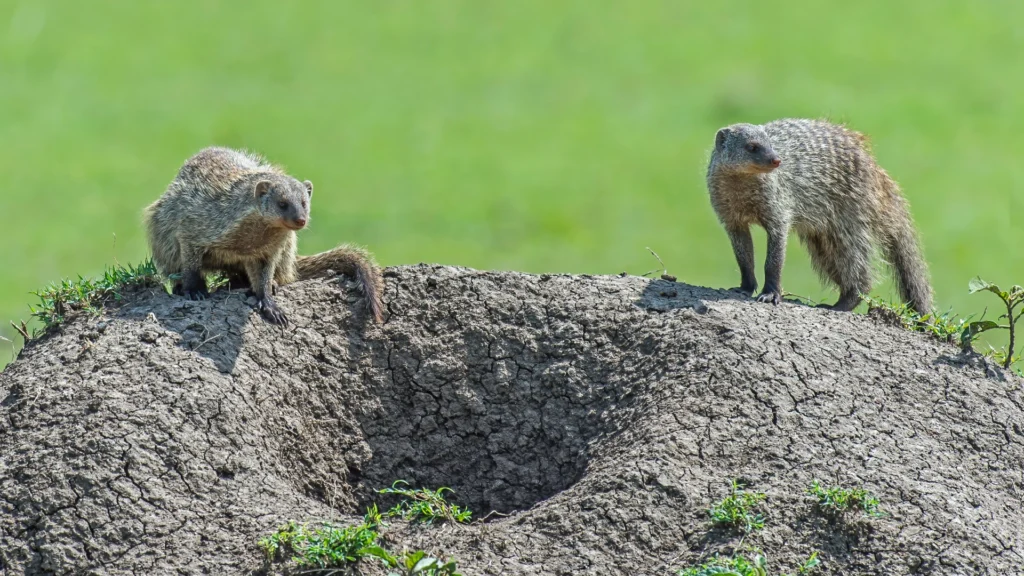
Banded mongooses sleep together in underground dens. They can dig but prefer to find an old termite mound, a hole made by another animal or a natural crevice to make a home in. They’ll stay in one den for up to a week before moving on to a new area to forage. They often return to their favourite dens.
Unfussy eaters
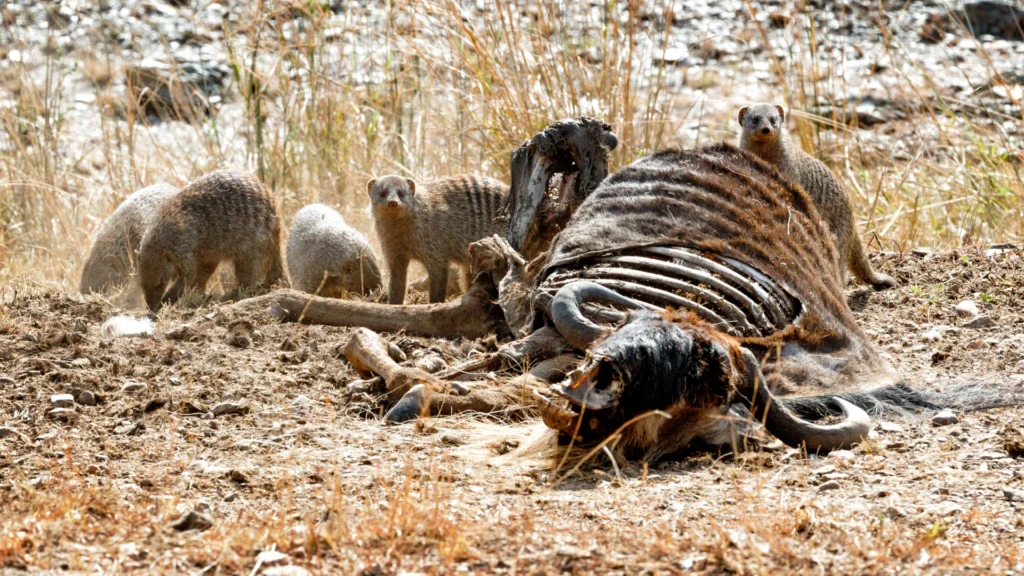
Mongooses are mainly insectivorous but will eat anything they can find, from small insects and lizards to fruit and eggs to rats and snakes.3https://www.ugandaparks.com/animals/mammals/banded-mongoose/ Banded mongooses do not like to share their food so will eat it straight away and try to keep it to themselves.1https://nationalzoo.si.edu/animals/banded-mongoose Researchers have discovered that, so banded mongooses can avoid fighting with each other over food, they become specialists in finding certain foods. This way a mongoose who is an expert at finding termites, for example, doesn’t need to compete with a mongoose who is an expert at finding millipedes.4https://phys.org/news/2018-03-fussy-mongoose-family-feuds.html
Family ties

A female is pregnant for two months and usually gives birth to four pups. Each pack of mongooses has about four litters every year from the breeding females. The pups grow up fast. Their eyes open after nine days, by four weeks old they have left the safety of the den, and by five weeks old they are taking part in all foraging expeditions.3https://www.ugandaparks.com/animals/mammals/banded-mongoose/ Like chimpanzees, any lactating female will feed the young and the males teach them how to find food.
Mamma mia!
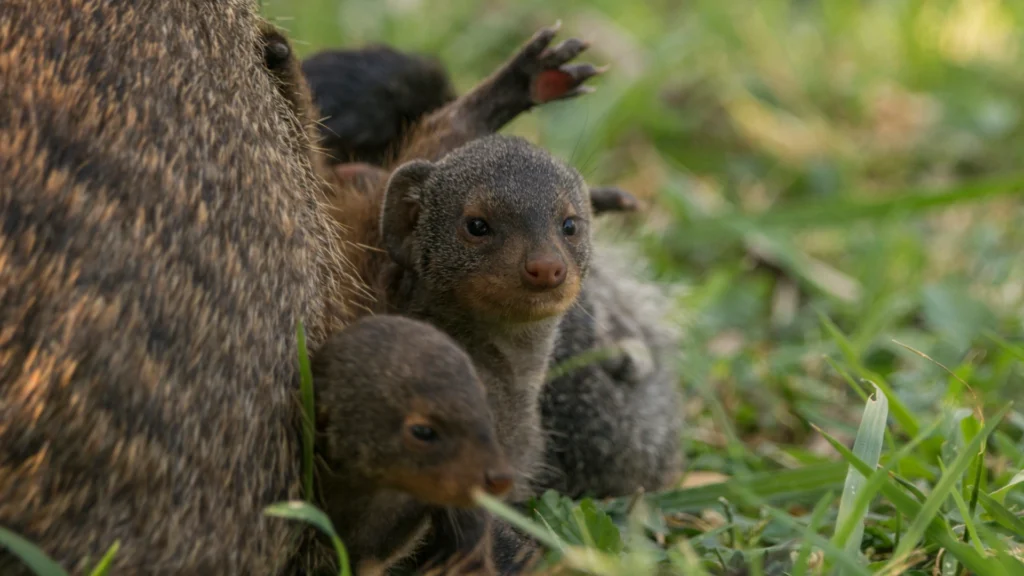
Mothers give birth on the same day in an underground den. This means it is hard to tell whose baby is whose. This creates harmony as a dominant older female won’t attack a younger mother’s pups.5https://www.nationalgeographic.com/animals/article/animals-mongooses-culture-learning
Escort service
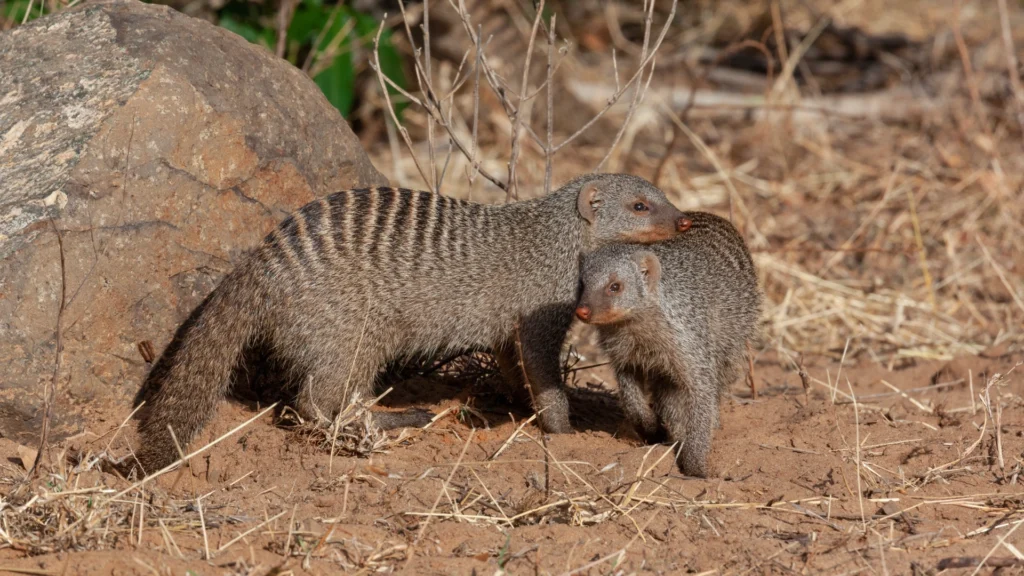
The banded mongoose is the only known animal to give pups an unrelated adult mentor. Called ‘escorts’, these mentors stay with the same pup for about two months, teaching them what and how to eat, carrying, protecting and educating them until they are old enough to feed themselves. The mentors are often male.5https://www.nationalgeographic.com/animals/article/animals-mongooses-culture-learning This cultural learning shows how intelligent and highly social these animals are.
Small but full of attitude
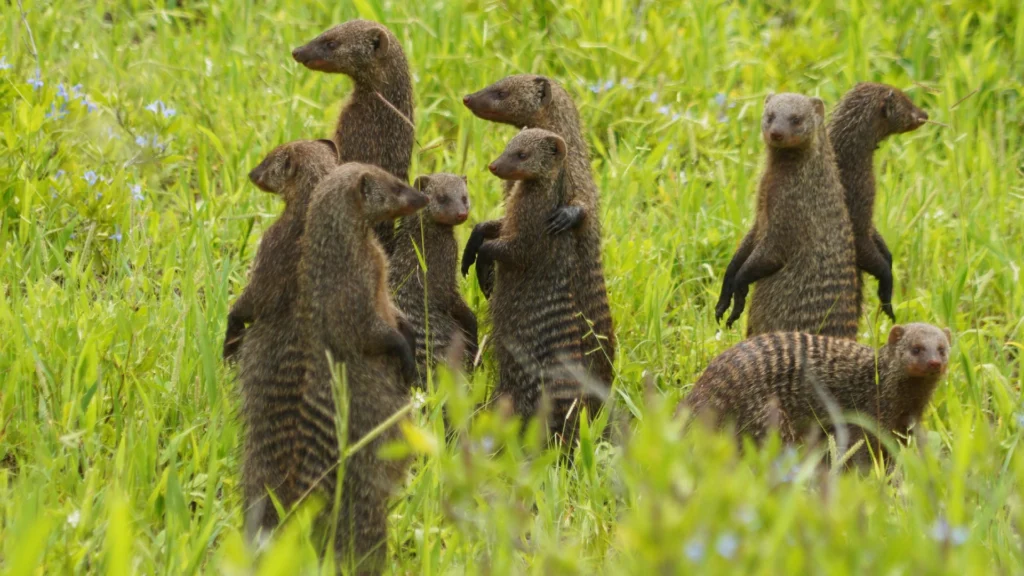
Although banded mongooses are only the size of a small cat, they pack a powerful punch. They might look cute from a distance but they can be extremely aggressive – to each other and their prey. If a pack of mongooses comes under attack from a predator, the mongooses will team up to counterattack the predator and chase it off. This makes mongooses a last resort meal for those that prey on them.
Terribly territorial
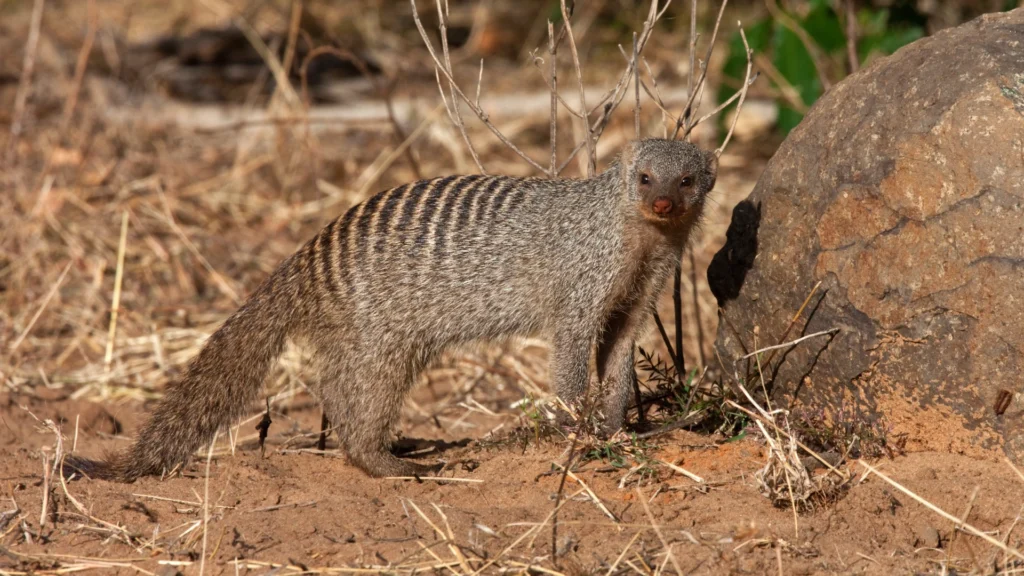
Banded mongooses are known to violently defend their pack and territory against rival packs and “wage war” on neighbouring territories.6https://www.newscientist.com/article/mg25734240-200-inside-the-complex-and-extremely-violent-world-of-warring-mongooses/ Conflict also occurs when there is competition for food and suitable mates. Because mongooses live in such tight packs and never let strangers in, they risk inbreeding so males and females invade another territory to mate with an unrelated mongoose. It also appears that conflict against other groups of mongooses tightens the bonds between the animals in the pack.7https://www.sciencedirect.com/science/article/pii/S0003347217300180 So, although at first the behaviour of mongooses might seem extreme, there does seem to be a purpose to it.
I’ll scratch your back if you scratch mine

In Queen Elizabeth National Park, banded mongooses have been seen removing the ticks from warthogs, much like how a cleaner wrasse removes parasites from larger fish in the sea. The warthog gets a clean, tick-free coat, and the mongooses get a tasty snack in return.8https://www.muzungubloguganda.com/adventure/fun-tourist-day-trip-mweya-mongoose-queen-elizabeth-national-park/
Threats to Banded Mongooses
Zoonotic diseases
Although the banded mongoose is not endangered, they still face threats from humans.
Banded mongooses are hunted and eaten as bushmeat.9https://www.nsf.gov/news/news_summ.jsp?cntn_id=127914 This is not only problematic for the mongooses but for humans too, as banded mongooses can carry a serious disease called leptospirosis – the world’s most common zoonotic disease. If humans come into close contact with an infected mongoose, or eat one, they can catch the disease and, if left untreated, develop severe health problems and even die.
Researchers have also found that in areas where human settlements have encroached on the habitat of banded mongooses, there is an increased risk of Campylobacter jejuni infections in mongooses.10https://journals.plos.org/plosntds/article/file?id=10.1371/journal.pntd.0007888&type=printable They found that where mongooses had made a den in man-made structures, over half of them tested positive for C. jejuni, whereas it was much rarer in mongooses living in a natural den. This means C. jejuni may be spreading between humans and mongooses, and humans living near mongooses will be more vulnerable to infection, which can cause bloody diarrhoea (frequently bloody), stomach pain, fever, headache, and vomiting.
Habitat loss

As a result of Uganda’s population growth, increased urbanisation, and an increased income for wealthier Ugandans, the demand for animal products is likely to dramatically rise in the coming years. The FAO estimates that by 2050, the demand for meat and milk products in Uganda will more than double and “the production of all types of meat and that of milk will increase by 164 and 41 per cent, respectively.”11https://www.fao.org/3/ca7009en/CA7009EN.pdf
In order to produce these animal products, land that was once beautiful and iconic savannah and forest – and a home to Uganda’s amazing wildlife, including the banded mongoose – will be turned into farmland. The conversion of land to agriculture will strip the wildlife of its natural habitat and put increasing pressure upon the land to support life. In the last 100 years, Uganda has lost 42 per cent of its forest cover, decreasing from 54 per cent to 12 per cent in 2017.12https://illuminem.com/illuminemvoices/deforestation-in-uganda-causes-and-recommendations Encroachment into Queen Elizabeth National Park by illegal cattle ranchers is common13https://conbio.onlinelibrary.wiley.com/doi/abs/10.1111/cobi.12538?campaign=woletoc and the National State of the Environment Report for Uganda 2014, attributes this to “the increasing demand of land for agriculture and fuel wood by the rapidly increasing population growth.”14https://nema.go.ug/sites/all/themes/nema/docs/FINAL%20NSOER%202014.pdf
Of course, a growing population needs food but it would be much more sustainable to meet these needs through the growing of crops instead of farming of animals. Meat and dairy foods require by far the most land and resources – this is because land is not only used for grazing but also for growing food for the animals. The more animal-based foods we eat, the more endangered our forests become. However, vegetable, grain and pulse crops are a far more efficient way to feed the growing population and use less land and other natural resources. A vegan diet is associated with only half the cropland demand, grazing intensity and overall biomass harvest of meat-based diets15https://www.nature.com/articles/ncomms11382 so switching to a vegan diet would have a phenomenal impact on reducing deforestation and land degradation in Uganda.
References
References
- 1
- 2
- 3
- 4
- 5
- 6
- 7
- 8
- 9
- 10
- 11
- 12
- 13
- 14
- 15

